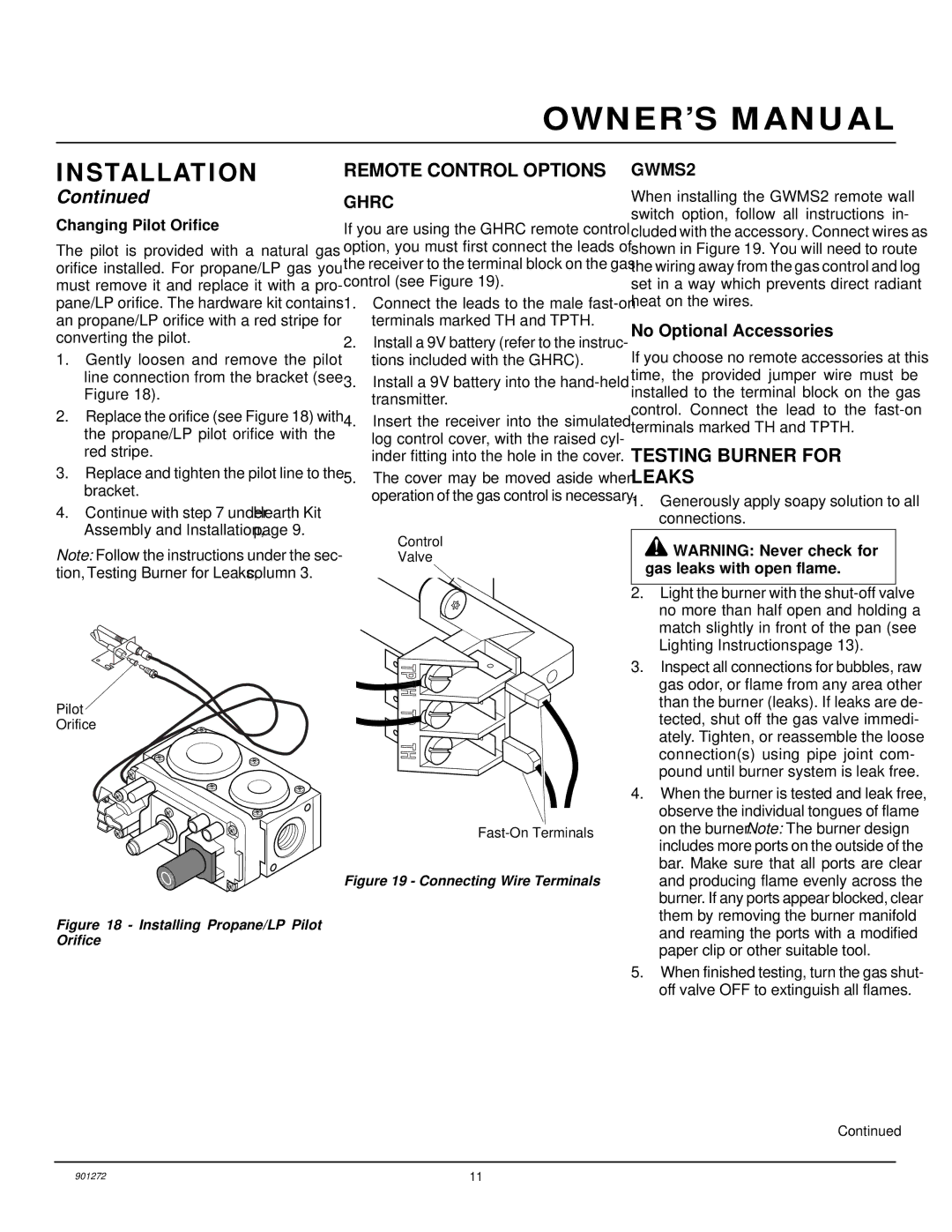
OWNER’S MANUAL
INSTALLATION
Continued
Changing Pilot Orifice
The pilot is provided with a natural gas orifice installed. For propane/LP gas you must remove it and replace it with a pro- pane/LP orifice. The hardware kit contains an propane/LP orifice with a red stripe for converting the pilot.
1.Gently loosen and remove the pilot line connection from the bracket (see Figure 18).
2.Replace the orifice (see Figure 18) with the propane/LP pilot orifice with the red stripe.
3.Replace and tighten the pilot line to the bracket.
4.Continue with step 7 under Hearth Kit Assembly and Installation, page 9.
Note: Follow the instructions under the sec- tion, Testing Burner for Leaks, column 3.
Pilot
Orifice
| O |
|
| F | |
O | F | |
N |
|
|
| TOL I | P |
|
| |
Figure 18 - Installing Propane/LP Pilot Orifice
REMOTE CONTROL OPTIONS
GHRC
If you are using the GHRC remote control option, you must first connect the leads of the receiver to the terminal block on the gas control (see Figure 19).
1.Connect the leads to the male
2.Install a 9V battery (refer to the instruc- tions included with the GHRC).
3.Install a 9V battery into the
4.Insert the receiver into the simulated log control cover, with the raised cyl- inder fitting into the hole in the cover.
5.The cover may be moved aside when operation of the gas control is necessary.
Control
Valve
Figure 19 - Connecting Wire Terminals
GWMS2
When installing the GWMS2 remote wall switch option, follow all instructions in- cluded with the accessory. Connect wires as shown in Figure 19. You will need to route the wiring away from the gas control and log set in a way which prevents direct radiant heat on the wires.
No Optional Accessories
If you choose no remote accessories at this time, the provided jumper wire must be installed to the terminal block on the gas control. Connect the lead to the
TESTING BURNER FOR LEAKS
1.Generously apply soapy solution to all connections.
![]() WARNING: Never check for gas leaks with open flame.
WARNING: Never check for gas leaks with open flame.
2.Light the burner with the
3.Inspect all connections for bubbles, raw gas odor, or flame from any area other than the burner (leaks). If leaks are de- tected, shut off the gas valve immedi- ately. Tighten, or reassemble the loose connection(s) using pipe joint com- pound until burner system is leak free.
4.When the burner is tested and leak free, observe the individual tongues of flame on the burner. Note: The burner design includes more ports on the outside of the bar. Make sure that all ports are clear and producing flame evenly across the burner. If any ports appear blocked, clear them by removing the burner manifold and reaming the ports with a modified paper clip or other suitable tool.
5.When finished testing, turn the gas shut- off valve OFF to extinguish all flames.
Continued
901272 | 11 |
